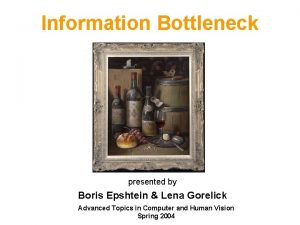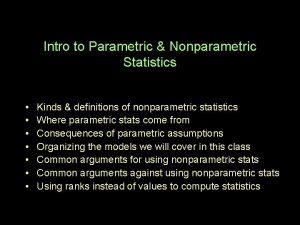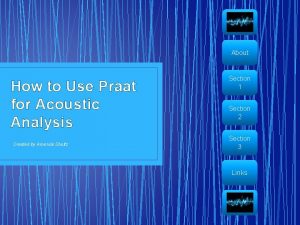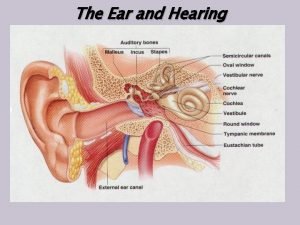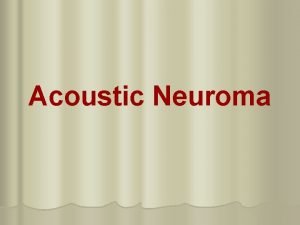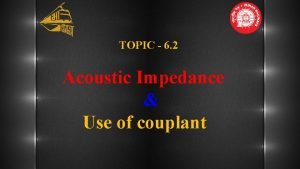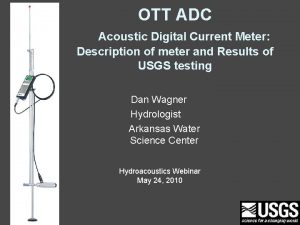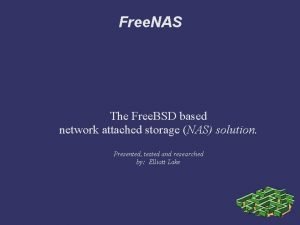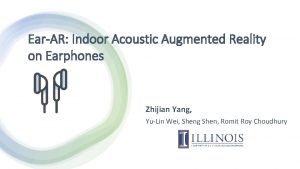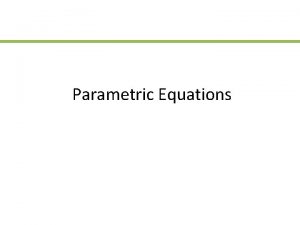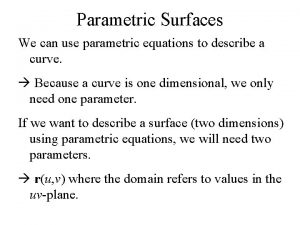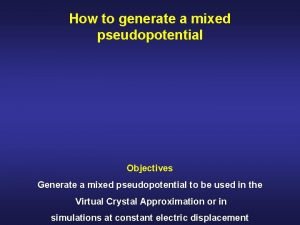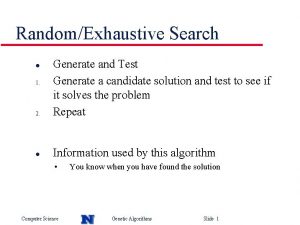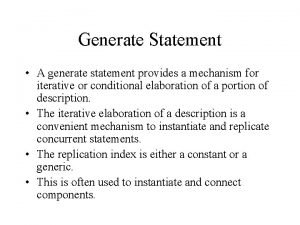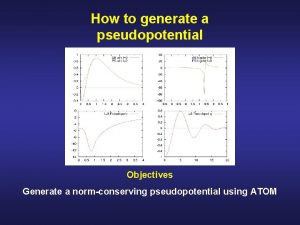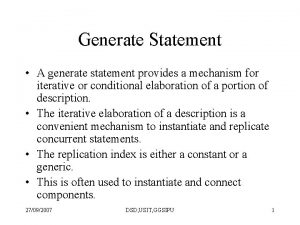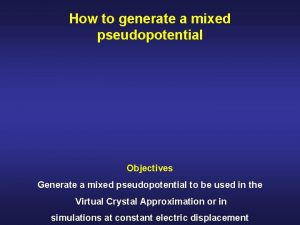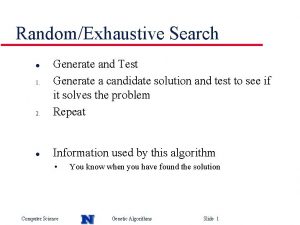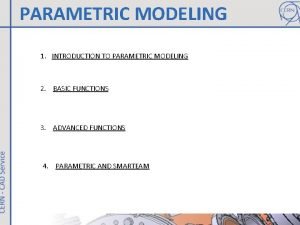Use of parametric acoustic sources to generate neutrinolike
















- Slides: 16

Use of parametric acoustic sources to generate neutrino-like signals Bou-Cabo Manuel Ardid-Ramírez Miguel Camarena-Femenía Francisco Espinosa-Resollo. Víctor Larosa Giuseppina Martínez-Mora Juan A (IGIC- Universitat Politècnica de València)

Contents Introduction Parametric acoustic sources Use of the technique for neutrino calibrators Studies with parametric generation (results) Conclussions Next steps

Introduction For the acoustic detection of neutrino it is very important to have a good calibrator in order to: Check and monitor the sensitivity Test the system and its reliability Due to a properties of neutrino-like signal (short bipolar pulse and directive ‘pancake’) it is not easy to reproduce it. The simplest approximation to do it could be to build a linear array with many elements (long array, which might be not easy to deploy). With this job we would like to study the possibility of using acoustic parametric sources to generate neutrino likesignals since they are quite directive.

Parametric acoustic sources When two high frequency signals (with close frequencies) are radiating from primary transducer to water medium they interact with each other in the area of non-linear interaction and thus produce number of signals with sum, difference, double frequencies and harmonics. The main operating frequency is difference one (F=f 1 -f 2) because it is low enough (due to closeness of high primary frequencies) and has narrow (24°) side-lobeless beam pattern in wide band that is easily adjusted by changing electrically the frequency one of primary waves. It’s possible due to non-linear properties of medium of propagation of sound

Parametric acoustic sources The parametric acoustic sources has some advantages with respect to traditional linear radiating systems: - Opportunity of obtaining narrow directional pattern at small overall dimensions of primary transducer. - Absence or low level of side-lobes in a directional pattern on a difference frequency. - Broad band of operating frequencies of radiated signals. The same effect can be used for transient signals: It is possible to generate a transient signal by a “special modulation” at a larger frequency in such a way that it “interacts” with himself in the medium providing the desired signal due to the difference of f 2 -f 1 frequencies from the spectral content of the short modulated signal

Use of the technique for neutrino calibration Neutrino acoustic signals are very directive bipolar transient signals Using parametric acoustic sources, it will be easier to reproduce the ‘pancake’ directivity with fewer sources, and in a more compact design: Cheaper and ease of deployment and operation in the sea (for example, instead of using 10 hydrophones in 5 m, use 3 in 0. 5 m) Warnings: Clever modulation needed? Yes, but clever people have already made a big part of the job Need large intensities? Yes, but since neutrino signals are weak, with reasonable intensities are enough

Studies with parametric generation Experimental setup: - Hydrophones used. Reson TC 4014 Reson TC 3027(1 MHz) Reson TC 3021(2 MHz) - Emitter hydrophone is fixed. - Receiver hydrophone moves along z axis. - For each position of z we have done a scan in x and y direction - Dimension of tank is -Sampling frequency (in reception) 20 MHz -> 1 MHz 2 MHz - Reference system.

Studies with parametric generation Modulation calculated from parametric theory: • Emitted signal (before amplification) The goals of this study are: - Obtain bipolar pulse after apply high frequency filter on received signal. - To characterize the directivity of parametric beam (x, y direction). After High Frequency filter Received signal

Studies with parametric generation(results) 1 MHz Transducer. (Exemple of reproduction of neutrino like signal). Reproduction of the shape of bipolar pulse after apply filter (distance E-R = 18, 4 cm) Parametric bipolar pulse is proportional to V 2: Non-linear effect!

Studies with parametric generation(results) 1 MHz Transducer (Directivity). FWH 6º FWH 8º dv means difference of maximum and minimum value of voltage. Directivity could be stimated by value of Full Width at Half Amplitude. Results for x scan ; 6º 50. 4 cm distance E-R 8º 79. 4 cm distance E-R

Studies with parametric generation(results) 1 MHz Transducer. FWH 7º Results for yscan : 7º 50. 4 cm distance E-R. 8º 79. 4 cm distance E-R FWH 8º

Studies in IGIC – UPV(Results) 2 MHz Transducer. FWH 4º Results for x scan 4º for both cases of distances E-R. 4º

Studies in IGIC – UPV(Results) 2 MHz Transducer. FWH 4º Results for y scan same directivity as x scan. FWH 4º

Studies with parametric generation(results) Relation of voltages beetwen original signal received and filtered signal is proportional factor 10. Seems that parametric beam haven’t a good efficiency!!! According to the fits of original and filtered signal, the attenuation of parametric beam is smaller than 1/r.

Next Steps Study this effect over large distances. We are working now in construction of an array using cylindrical transducers First step: to know the behavior of one single piezo- ceramics. Second step: Design and construct the array

Conclusions First results in the study of the parametric technique to generate directive neutrino-like signals seem very promising. Therefore, we will continue in this direction, aiming to design and build a prototype based on this technique.
 Parametric and non parametric test
Parametric and non parametric test Parametric and non parametric algorithms
Parametric and non parametric algorithms Parametric vs non parametric test
Parametric vs non parametric test Parametric test and non parametric test
Parametric test and non parametric test How to use praat for acoustic analysis
How to use praat for acoustic analysis Print sources of information
Print sources of information The importance of water management
The importance of water management External auditory meatus
External auditory meatus What is the function of the external acoustic meatus
What is the function of the external acoustic meatus External acoustic meatus
External acoustic meatus Rollover phenomenon in acoustic neuroma
Rollover phenomenon in acoustic neuroma Universe expanding faster than should be
Universe expanding faster than should be Acoustic impedance of steel
Acoustic impedance of steel Bone remodeling facial exercise
Bone remodeling facial exercise Acoustic digital current meter
Acoustic digital current meter Freenas demo
Freenas demo Ear-ar: indoor acoustic augmented reality on earphones
Ear-ar: indoor acoustic augmented reality on earphones

